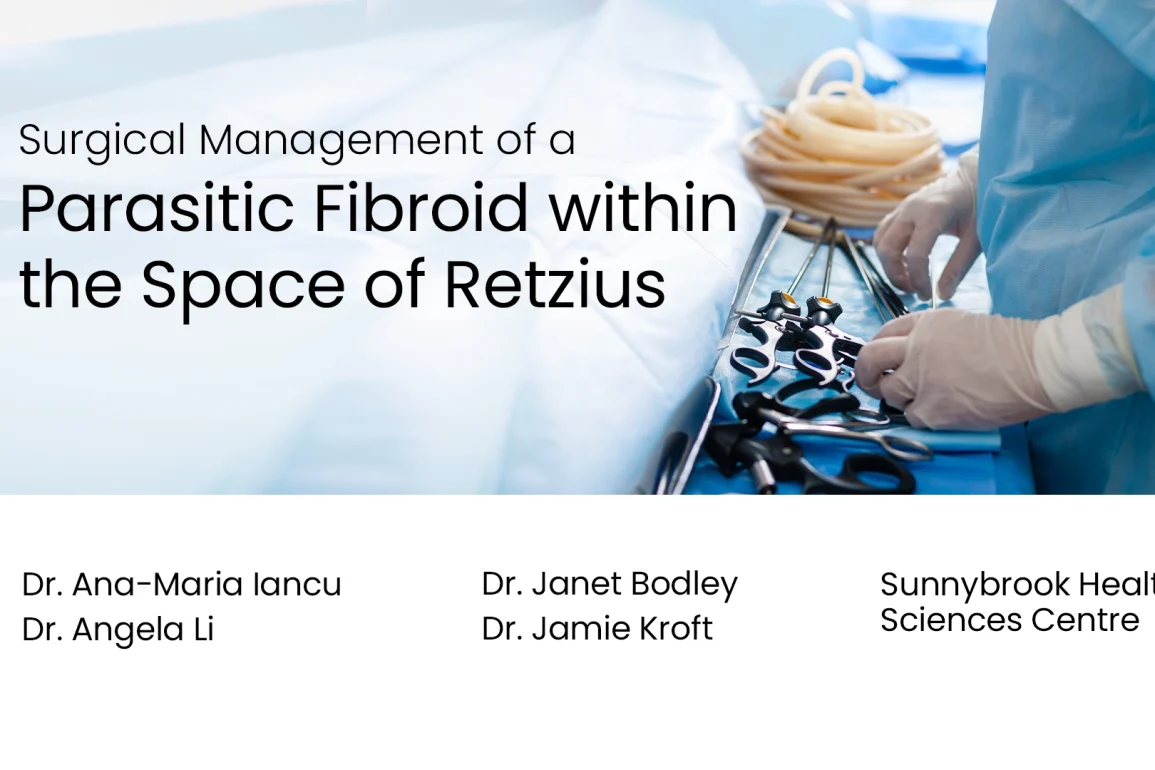Table of Contents
- Procedure Summary
- Authors
- Youtube Video
- What is a Parasitic Fibroid within the Space of Retzius?
- What are the Risks of a Parasitic Fibroid within the Space of Retzius?
- Video Transcript
Video Description
CANSAGE conference presentation on parasitic fibroid excision, covering clinical background, surgical decision-making, technique, and post-op outcomes.
Presented By
Affiliations
Sunnybrook Health Sciences Centre
Watch on YouTube
Click here to watch this video on YouTube.
What is a Parasitic Fibroid within the Space of Retzius?
A parasitic fibroid within the space of Retzius is a rare type of extrauterine leiomyoma that develops in the retropubic (prevesical) space between the pubic bone and the bladder. Here’s what is important to know:
-
Definition and Pathogenesis: Parasitic fibroids account for less than 1% of all fibroids and arise when a pedunculated uterine fibroid detaches from the uterus and establishes a new blood supply, or from fibroid tissue disseminated during prior surgery such as myomectomy or hysterectomy with morcellation.
-
Anatomical Location: The space of Retzius lies between the pubic symphysis anteriorly and the bladder posteriorly. Fibroids in this space may compress the bladder, urethra, or pelvic nerves.
-
Clinical Presentation: Patients often present with lower urinary tract symptoms, pelvic discomfort, or a palpable pelvic mass. Symptoms vary depending on the size and exact location of the fibroid.
-
Diagnosis: Imaging with ultrasound or MRI typically reveals a well-circumscribed mass anterior to the bladder. Preoperative imaging is critical to distinguish it from bladder, urethral, or pelvic wall tumors.
-
Management: Laparoscopic or open excision is the treatment of choice. Careful dissection of the space of Retzius with identification of surrounding structures such as the bladder, urethra, and inferior epigastric vessels is essential for safe removal.
What are the Risks of a Parasitic Fibroid within the Space of Retzius?
Surgical removal of a parasitic fibroid in this location carries specific risks due to its proximity to critical pelvic structures.
-
Bladder Injury: The fibroid’s close relationship to the bladder increases the risk of bladder perforation or postoperative urinary leak.
-
Urethral Trauma: Dissection near the bladder neck and proximal urethra may cause urethral injury or postoperative voiding dysfunction.
-
Vascular Injury: The space of Retzius contains the inferior epigastric vessels and venous plexuses, which can lead to significant bleeding if injured.
-
Nerve Injury: Injury to pelvic nerves or the obturator nerve may cause postoperative pain or lower limb weakness.
-
Recurrence or Residual Tissue: Incomplete removal of fibroid tissue can lead to regrowth or persistent symptoms.
-
General Surgical Risks: Infection, hematoma, or adhesion formation may occur after surgery.
Preoperative imaging, intraoperative cystoscopy, and meticulous surgical technique help minimize these risks and ensure safe and effective excision of the fibroid.
Video Transcript:
Today, we’re going to review a video of our surgical management of a parasitic fibroid within the space of Retzius. Parasitic fibroids account for less than 1% of all fibroids. They arise either by auto-amputation of a pedunculated fibroid, or through tissue dissemination at the time of surgery.
Such fibroids have been found in a variety of anatomic locations, and symptomatology and potential complications vary with these locations. Our patient is a 47 year old, G0, female, presenting with lower urinary tract symptoms and pelvic discomfort. Medical management had been ineffective. She had undergone a minimally invasive hysterectomy for fibroids eight years prior.
Pelvic scenography demonstrated the presence of a 4 cm smooth mass in close proximity to the proximal urethra. Pelvic MRI, localised the mass as anterior and inferior to the bladder, with an appearance consistent with a parasitic fibroid.
After laparoscopic access to the abdomen and pelvis was obtained, the pelvis was inspected, and a rounded, smooth and firm mass was noted anterior to the vaginal vault. The Foley catheter balloon can be seen to the right of the mass. A ring forceps is seen within the vaginal vault, below the level of the mass.
Given the proximity between the bladder and the mass, methylene blue was instilled into the bladder to ascertain its location. Upon installation of methylene blue, the mass was no longer recognisable, trans-peritoneally, suggesting that the bladder was juxtaposed anteriorly to the mass, as suggested by MRI findings.
We then performed cystoscopy to ensure that the bladder was free of any lesions. Both ureteric orifices were appropriately visualised. The bladder was indented by the mass extrinsically, however there was no evidence of the mass having any intracystic components.
In order to gain access to the mass, the space of Retzius was opened using the CO2 laser by incising between the medial umbilical ligaments. Dissection between the medial umbilical ligaments ensures avoidance of the inferior epigastric vessels. The borders of the space of Retzius are the parietal peritoneum superiorly, the symphysis pubis anteriorly, the arcus tendineus fascia pelvis laterally, the bladder posteriorly, and the proximal urethra and bladder neck inferiorly.
The perirenal adipose tissue was dissected while the bladder was insufflated with CO2 in order to localise the dome. The dissection was carried down to the level of the pubic rami and the iliopectineal ligaments were exposed bilaterally. The mass was then identified within this space, anterior to the bladder dome.
The mass was subsequently dissected out of the underlying tissue, using a combination of carbon dioxide laser dissection, and bipolar cautery. Haemostasis was assured within the defect. Cystosufflation was once again performed in order to both delineate the outline of the bladder, as well as ensure that there were no defects within the bladder. The bladder was found to be intact.
Once the mass was removed, the incision into the space of Retzius was closed. We recommend a monofilament suture, such as 2-0 Maxon, to achieve this closure. The suture was secured extracorporeally using a Roeder Knot, which was subsequently pushed to intra corporeally, using a knot pusher.
The patient was discharged home on post-operative day zero after a successful voiding trial. She recovered well. At her post-operative visit, she reported significant improvement in her lower urinary tract symptoms.
To sum up, parasitic fibroids should be considered in the differential diagnosis for pelvic masses. Surgical management may require involvement by multiple surgical specialities, however can result in a significant relief in patient symptoms.



